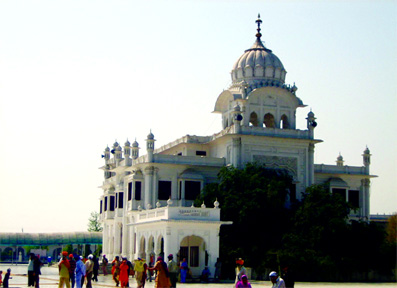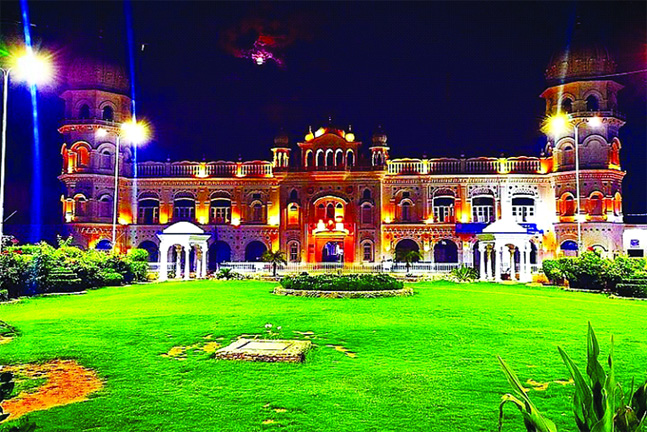
 Gurdwara Sri Ber Sahib
Gurdwara Sri Ber Sahib
This Gurdwara is situated on the banks of the river Kali Bein near Sultanpur Lodhi, in Punjab. Shri Guru Nanak Dev ji used to perform his ablutions in the river Bein. It was here that he meditated under a Ber (plum) tree for 14 years. According to legends, he disappeared under its waters one day only to emerge three days later as the enlightened Guru. His first words upon his emergence were that there is no Hindu, no Mussalman. The Gurdwara’s ground marks the place he entered the rivulet. Built by the Maharaja of Kapurthala in the mid 20th century, the Gurdwara has a three-storeyed building with a marble sanctum, octagonal pillars and stucco designs on its entrance.
Gurdwara Khandh Sahib
The name of this Gurudwara comes from ‘kachi khandh’ or mud wall which stood at the site of the Gurdwara in accordance with local traditions during Shri Guru Nanak Dev ji’s wedding. It is located at Kandhli gate, Batala Punjab. He sat beside the wall awaiting formal reception by his hosts. An old lady at the time had pointed out the dilapidated condition of the wall to which he reassured that it was safe. Thus, the wall became a revered object for his devotees. They even constructed a memorial in front of it. A mud wall encased in glass and plastered neatly next to Guru Granth Sahib is a symbolic representation of the previous one.
Gurdwara Pathar Sahib
25 miles away from Leh lies Gurdwara Pathar Sahib. It is situated on the Leh-Kargil road and is situated 12,000 ft above sea level. It was built in 1517 AD in order to commemorate Sri Guru Nanak Dev ji’s visit to Ladakh. During his lifetime, Shri Guru Nanak Dev traveled to many places and even went to Tibet. Some Tibetans even rever Guru Nanak Dev ji as a Buddhist monk with the name, Guru Gopka Maharaj, according to the Dalai Lama.
Gurdwara Sri Reetha Sahib
Situated near Diyuri village in the Champawat district of Uttarakhand this Gurudwara holds special significance for Sikhs. Along with Bhai Mardana ji, Shri Guru Nanak Dev ji himself visited the place. He asked Mardana ji to eat a reetha (soapnut) as they were sitting under its tree. Usually slightly bitter, the reetha had tasted sweet. Nearby ascetics got wonder-struck by this feat. Later, all reethas where Shri Guru Nanak Dev ji sat were found to have turned sweet.
Gurdwara Shri Pehli Patshahi
Gurdwara Shri Pehli Patshahi means the Gurdwara of the first master. It is situated near Lakhpat in Gujarat. Shri Guru Nanak Dev ji visited here during his first and fourth udasis (missionary journeys). He visited the site on his way towards Mecca during his fourth udasi. His rare personal possessions are retained in this Gurdwara. Thus, making it a must-visit place for any devotee.
Darbar Sahib Gurdwara
Gurdwara Darbar Sahib Kartarpur, also called Kartarpur Sahib, is a gurdwara in Kartarpur, located in Shakargarh, Narowal District of Punjab, Pakistan.
It is built on the historic site where the founder of Sikhism, Guru Nanak, settled and assembled the Sikh community after his missionary travels (udasis to Haridwar, Mecca-Medina, Lanka, Baghdad, Kashmir and Nepal and lived for 18 years until his death in 1539. It is one of the holiest sites in Sikhism, alongside the Golden Temple in Amritsar and Gurdwara Janam Asthan in Nankana Sahib.
The gurdwara is also notable for its location near the border between Pakistan and India. The shrine is visible from the Indian side of the border. Indian Sikhs gather in large numbers on bluffs to perform darshan, or sacred viewing of the site, from the Indian side of the border.
The Kartarpur Corridor was opened by Pakistani Prime Minister Imran Khan on 9 November 2019, the anniversary of the fall of the Berlin Wall and just days before the 550th birth anniversary of Guru Nanak. This historic moment officially allowed Indian Sikh pilgrims rare visa-free access to the site in Pakistan. It is also claimed to be the largest gurdwara in the world. The gurdwara was built to commemorate the site where Guru Nanak, the founder of Sikhism, settled after his missionary work and did farming. Guru Nanak founded the Kartarpur town by Ravi River in 1504, plowing the fields and setting up a community kitchen, or Langar.He assembled a Sikh commune there, and lived for 18 years until his death on 22 September 1539. The gurdwara is built where Guru Nanak is said to have died.[5] It is therefore the second holiest site of the Sikh religion after Gurdwara Janam Asthan – the birthplace of Guru Nanak located in Nankana Sahib, Pakistan.
Here, Guru Nanak gave the three principles of Kirat Karo, Naam Japo, Vand Chako, which means work hard for a livelihood, keep remembering God and share your bounties with the world. Guru’s teachings have been peace, harmony, and universal brotherhood. Guru Nanak believed in equality between castes, religions, and genders and gave the word Ik Onkar meaning there is only one God.
According to Lahore-based art historian Fakr Syed Aijazuddin, the shrine houses the last copies of the original Guru Granth Sahib. A Sikh pilgrim remarked, “Every step here reminds us of the Guru’s life”. Indian Sikhs gather in large numbers on bluffs on the Indian side of the border to obtain darshan, or sacred viewing, of the site. As per popular legend, there was a dispute between the local Hindus and Muslims after Guru Nanak died. Muslims, who saw him as their pir, wanted to bury him while Hindus, who claimed Nanak as their guru, wanted to cremate his body. But the legend follows that Guru Nanak’s body was turned into flowers, which were then divided between the two communities.
Gurdwara Sri Nankana Sahib
Nankana Sahib is located in Pakistan about 50 miles west of Lahore. Originally known as Raipur, it went by the name of Rai Bhoi di Talwandi at the time of Guru Nanak’s birth. Nankana is the site of several historic gurdwaras built to commemorate miraculous occurrences during Guru Nanak’s life. The gurdwaras are surrounded by 18,750 acres of land bestowed to Guru Nanak by Rai Bular Bhatti, the Muslim headman of Talwandi village. His descendants have revered Guru Nanak through the centuries.
Gurdwara Nankana (Janam Asthan) is built at the site of Guru Nanak Dev’s birthplace and childhood home. It is the most prominent of all the gurdwaras located in the town of Nankana, Pakistan. It is the host of annual gurpurab festivities commemorating Guru Nanak’s birth which are celebrated on the full moon in the latter part of the year.





Be the first to comment